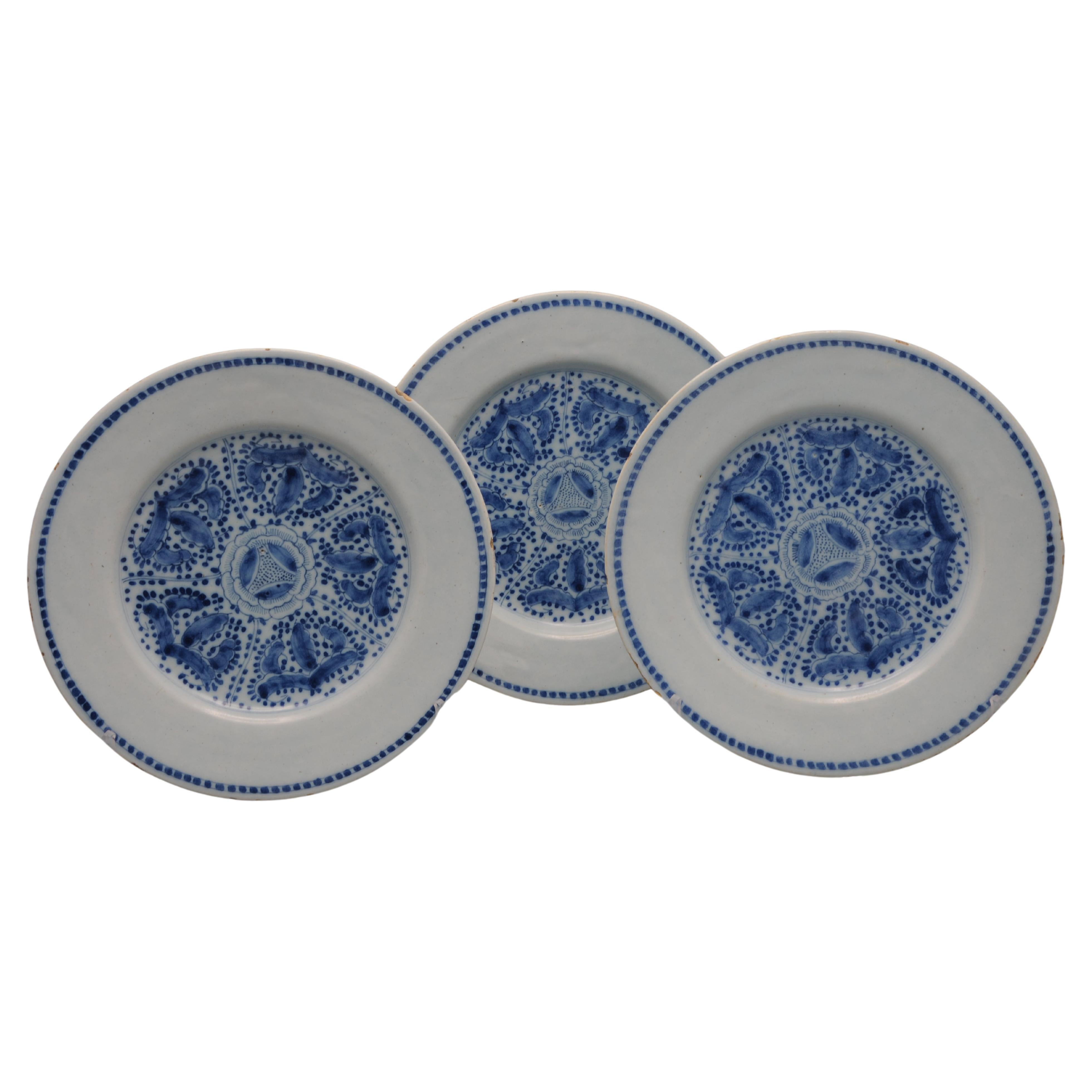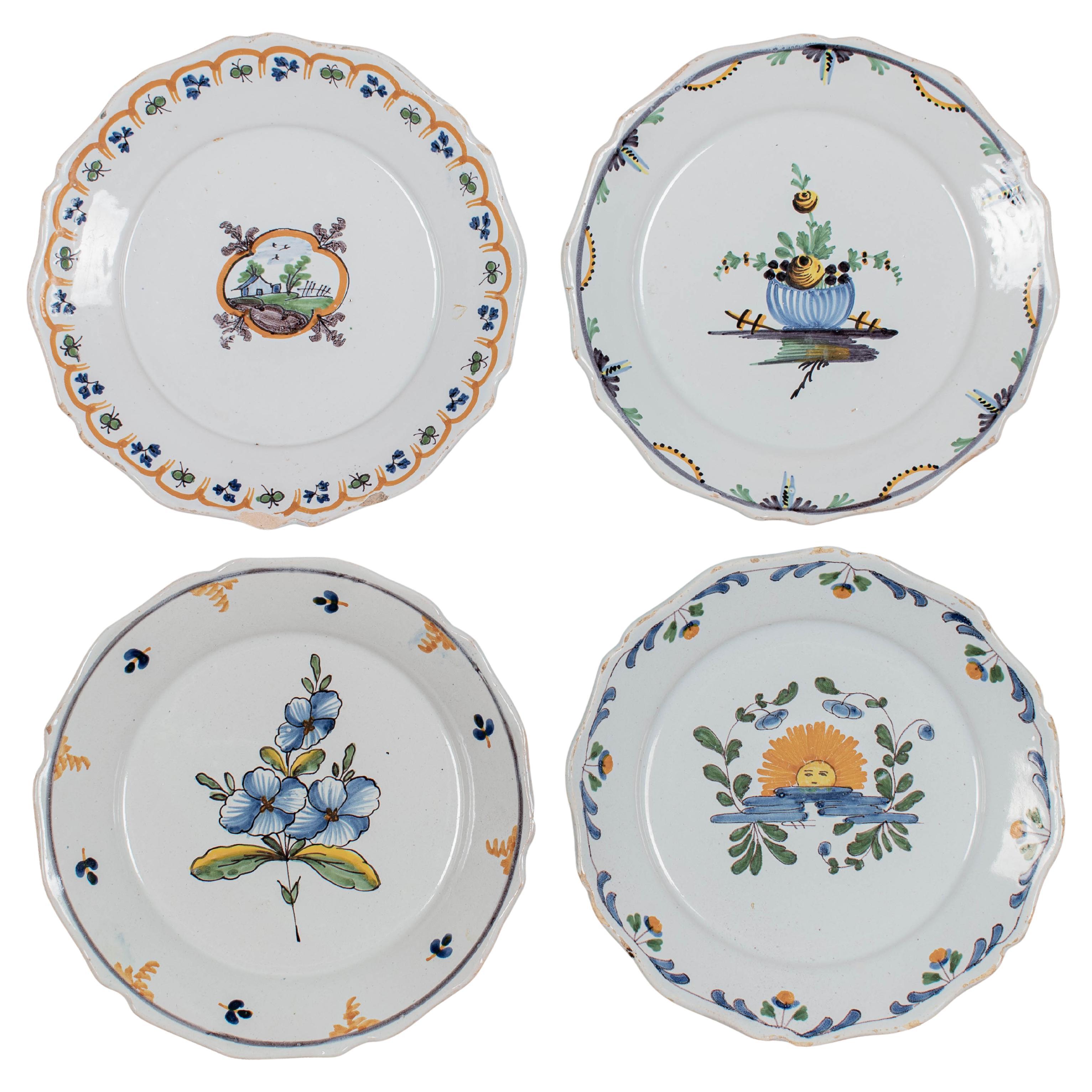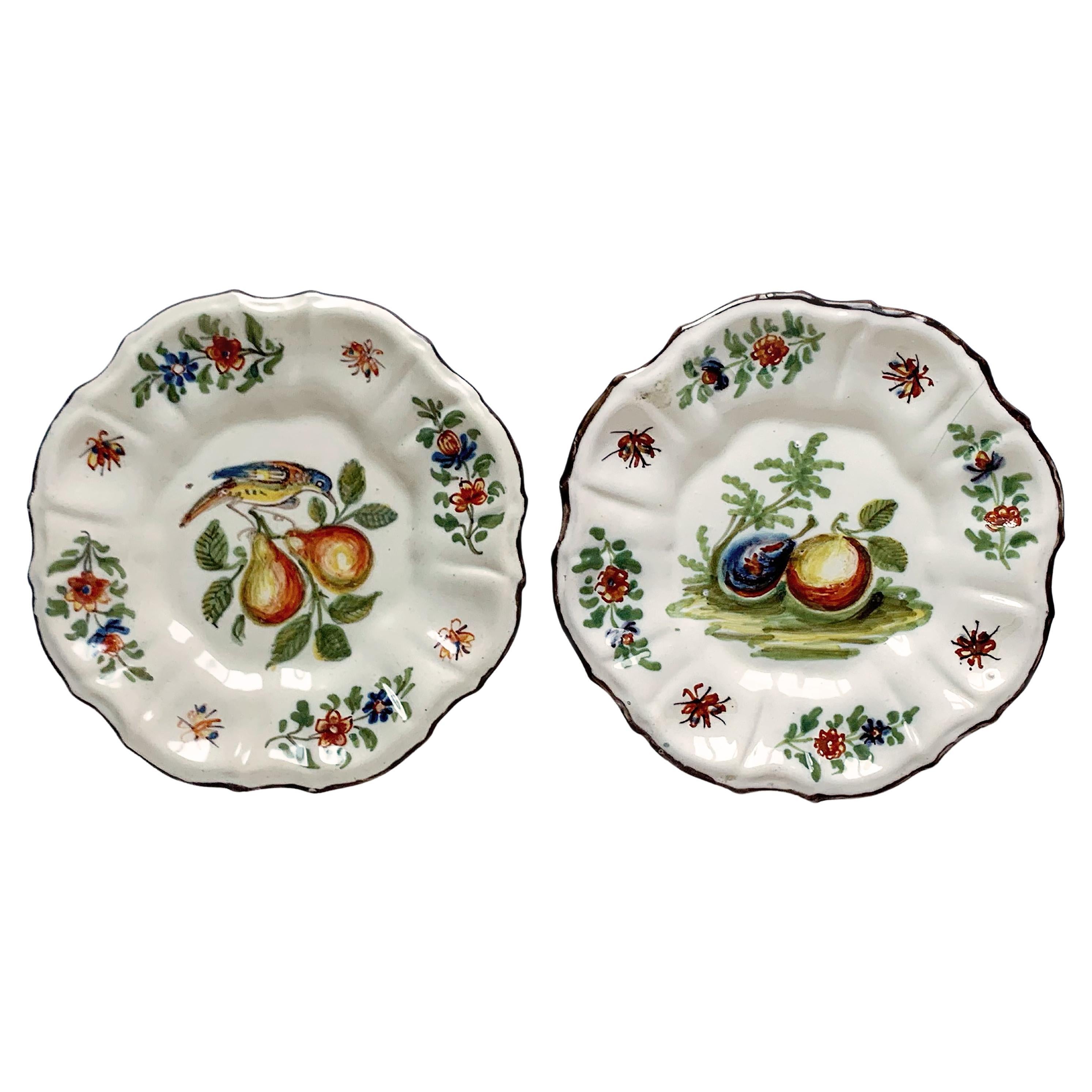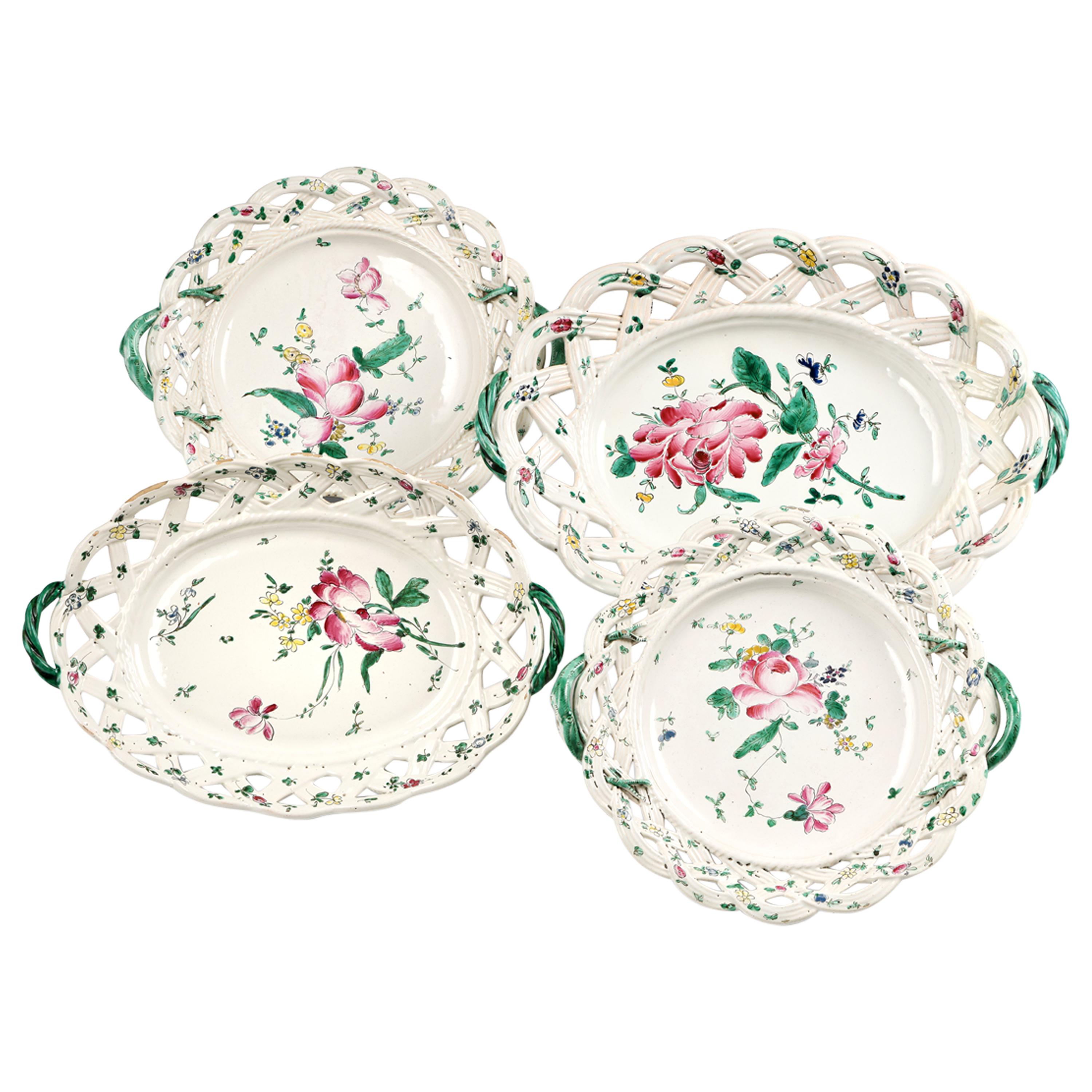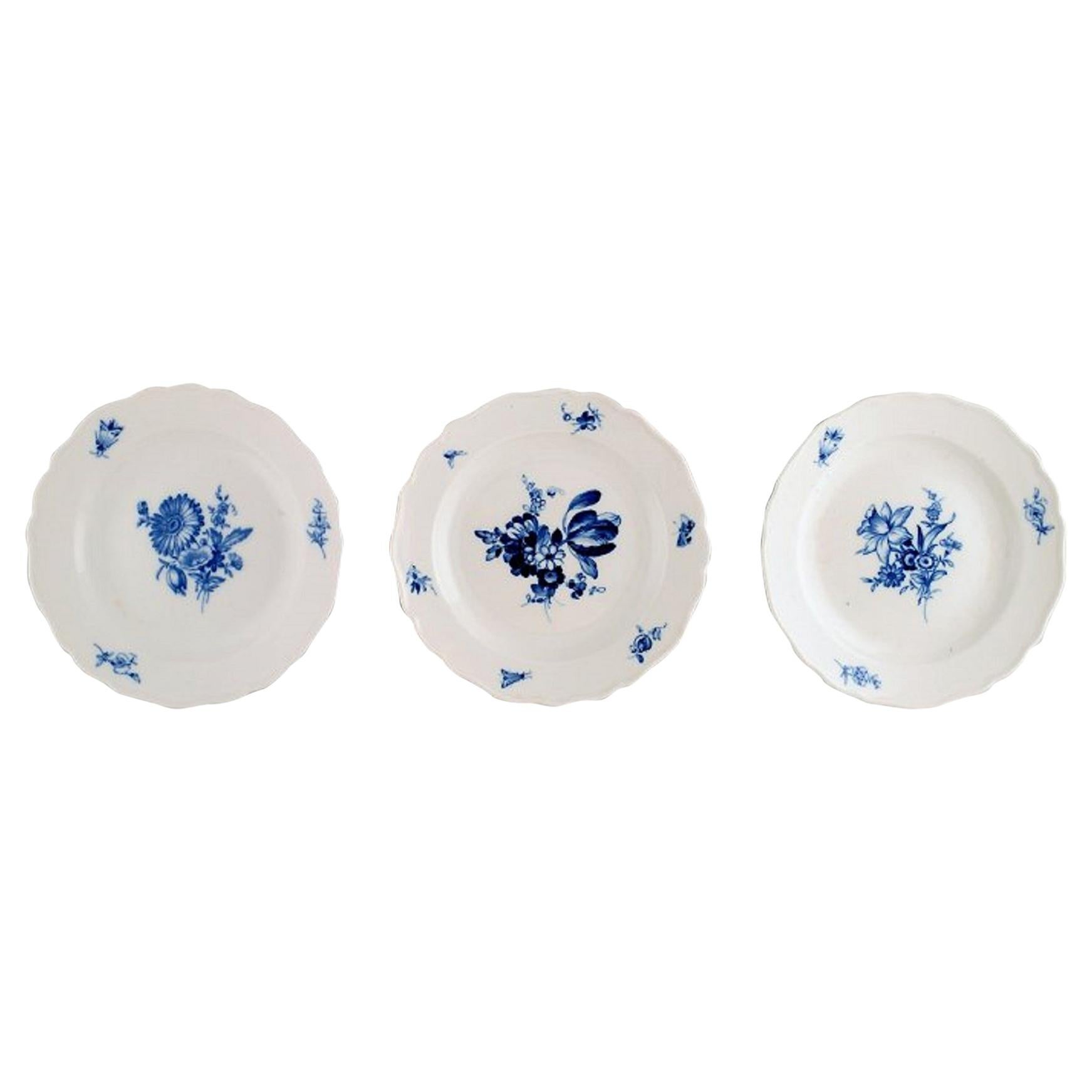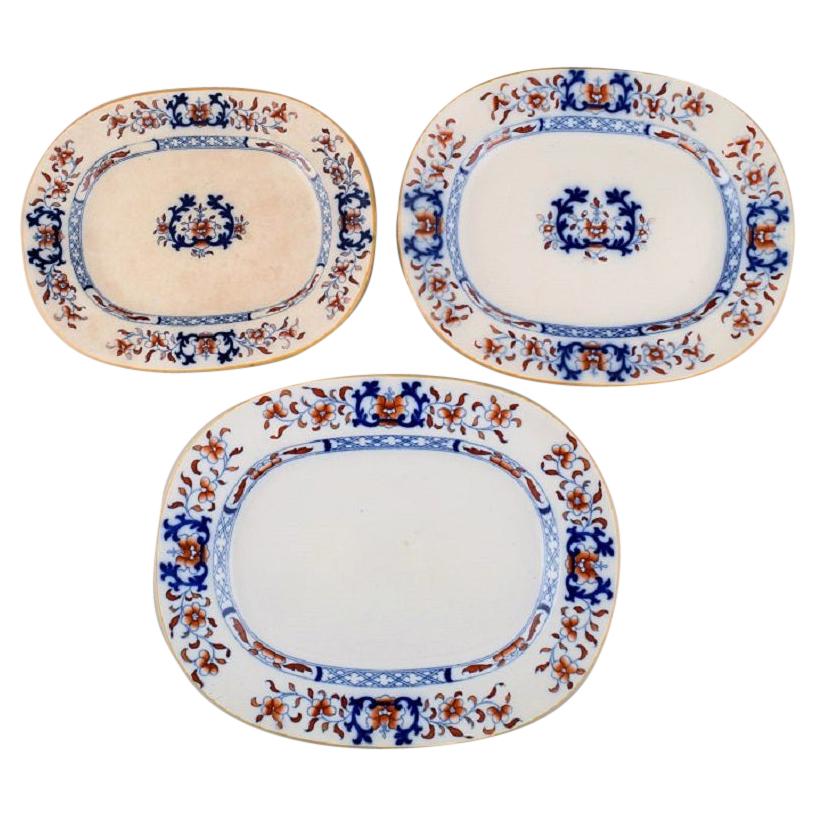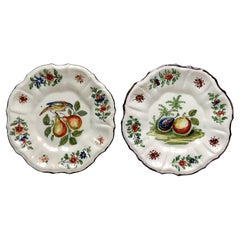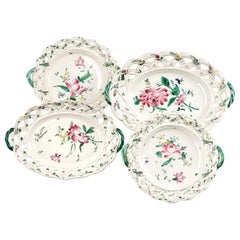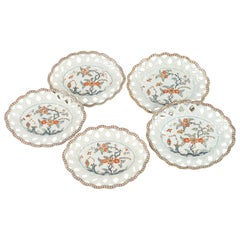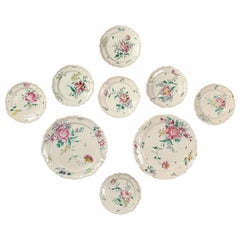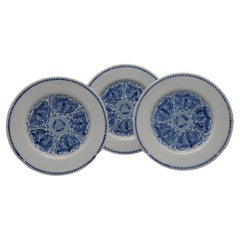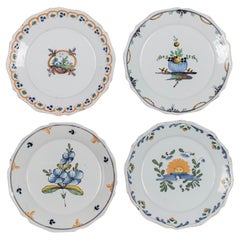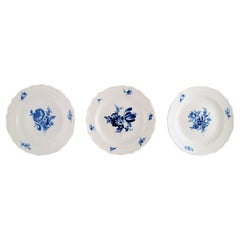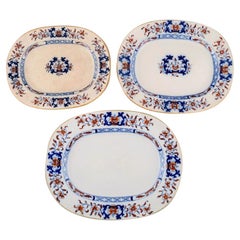Articoli simili a Three Dishes, Antonio Maria Coppellotti Factory, Lodi, Italy, Circa 1745
Caricamento del video
Vuoi altre immagini o video?
Richiedi altre immagini o video al venditore
1 di 18
Three Dishes, Antonio Maria Coppellotti Factory, Lodi, Italy, Circa 1745
2500 €per set|IVA inclusa
Informazioni sull’articolo
Pair of round dishes and a small oval tray
Antonio Maria Coppellotti factory
Lodi, circa 1745
High fire polychrome maiolica
Dishes size: diameter 9.44 in, height 0.78 in (24 cm, 2 cm)
Weight: 0.66 lb each (300 g)
Tray size: 9.44 in x 8.26 in x height 0.78 in (24 x 21 x 2 cm)
Weight: 0.66 lb (300 g)
State of conservation: the two round dishes are intact except for slight flaking in the glaze and wear. The tray shows a clean break restored with antiquarian restoration on the front, but legible on the reverse.
The three dishes have a traditional shape without a support ring, with a short, barely sloping brim and a mixtilinear profile. The rim is wavy, ribbed, and striped with two thin parallel lines of iron-red orange color with an additional thin wavy blue line on the tray.
The decoration is made using a high fire technique and is polychrome with a thick, creamy-white glaze with a few pinpoints.
The decoration of groups of little flowers starts from two broad tufts of lanceolate leaves and spreads in symmetrical fronds reaching the brim and extending to the middle of the well. In the center of the oval plate there is a small asterisk.
A close comparison comes to us from an oval tray which bears, on the verso, the initials AMC. It is now preserved in the collections of the Museo d’Arti Applicate at the Castello Sforzesco in Milan (R. Ausenda, ed., Musei e Gallerie di Milano. Musei e Gallerie di Milano. Museo d’Arti Applicate. Le ceramiche. Tomo secondo, Milan 2000, p. 190, no. 230). The presence of the mark in the comparison specimen confirms the attribution of these elegant creations to high fired “ferrosi” (with iron color) foils that characterize a specific production of works on forms typical of the Lodi production in the first half of the 18th century. Other comparison specimens are published in monographic repertories. These include an unusual coffee pot with a Middle Eastern oriental form which was exhibited at the Poldi Pezzoli Museum in the celebrated 1964 exhibition. Also recognizable from the same exhibition are a tureen and a sugar bowl, all consistent in decorative choice (G. Gregorietti Museo Poldi Pezzoli, Maioliche di Lodi, Milano e Pavia (catal.), Milan 1964, no. 46). More unusual in morphology and ornamentation are a coffee pot and a jug in which the decoration is associated with the depiction of a “castelletto,” a theme which was often used in Lombard ceramic production in general (Felice Ferrari, La ceramica di Lodi, Lodi 2003, pp. 118, 119; nn. 33-34, and M. L. Gelmini, Maioliche lodigiane del '700, Milan 1995, pp. 102-103; nn. 83-87).
The three dishes are certainly works of the Lodi manufacture by Antonio Maria Coppellotti, as they adhere to all of its compositional standards.
The painting expertise of the decorators from Lodi, especially in color control, set a standard: the red, sourced from now-depleted Eastern quarries and known as "bolo armeno", was carefully managed during firing. This was achieved by applying a thin brushstroke of enamel over the sections affected by the chromatic range. This technique helped contain the "boiling" of the color during firing, resulting in remarkable outcomes where the relief and red-orange color characterize the production.
The earliest records of the Coppellotti family as a family of potters come from archival documents which, between 1639 and 1641, testify to the official application, by a certain Giovanni Coppellotti, to the relevant authorities for permission to open a maiolica factory in Lodi.
The factory, located near the church of San Filippo seems to have been immediately quite successful. However, it was only in 1679, when the management of the factory passed to Antonio Giovanni Maria Coppellotti – the son or perhaps grandson of the original Giovanni - that the production reached the peak of success and became an example for the main Italian manufactures of the time, especially those in Veneto and Liguria.
The activity continued under the direction of Anton Maria Junior until about 1750, to resume, after a brief interruption, with Bassano Coppellotti in collaboration with a number of other directors, including G. Moroni, Giulio Berinzaghi and, from 1771, the Pedrinazzi. Finally, in 1787, a new municipal ordinance ordered the definitive closure of the factory due to financial difficulties.
The maiolica produced during the initial period are characterized by the use of a thick, velvety enamel and have ornaments ranging from monochrome turquoise with Italian (ruins, castles, flowers) and French motifs ("rabeschi", ramage), to decorations in the manner of Chinese porcelain and oriental inspiration.
Of particular importance are ornaments of Baroque fruit which show the amazing relief effects produced by using the red tone called "Armenian bolus". This great variety of decorations appeared between 1735 and 1740 by which time, alongside the production of turquoise monochrome, polychromy with high fire technique was firmly established. The brand precisely identifying the maiolica of this factory is rare and uses a woven "AMC" monogram. It was sometimes done in different colors and was sometimes accompanied by the names of the painters and modelers of the manufacture.
Bibliography:
C. Baroni, La maiolica antica di Lodi, in “Archivio storico lombardo” LVIII, 1930, pp. 448 s., 455-457;
A. Minghetti, I ceramisti italiani, Roma 1946, p. 129;
S. Levy, Maioliche settecentesche lombarde e venete, Milano 1962, pp. 15-17, tavv. 121-150;
G. Gregorietti Museo Poldi Pezzoli, Maioliche di Lodi, Milano e Pavia (catal.), Milano 1964, pp. 15 s., con ill.;
A. Novasconi - S. Ferrari - S. Corvi, La ceramica lodigiana, Milano 1964, pp. 23, 27, 34-36, 47, ill. pp. 53-121;
O. G. C. Sciolla, Museo civico di Lodi, Bologna 1977, pp. VIII s.; tavv. pp. 72-76, 78;
M. L. Gelmini, Maioliche lodigiane del ‘700, Milano 1995, pp. 102-103; nn. 83-87
R. Ausenda, a cura di, Musei e Gallerie di Milano. Museo d’Arti Applicate. Le ceramiche. Tomo secondo, Milano 2000, p. 190, n. 230;
Felice Ferrari, La ceramica di Lodi, Lodi 2003, pp. 118-127.
- Attribuito a:Antonio Maria Coppellotti (Fabbricante)
- Dimensioni:Altezza: 2 cm (0,79 in)Diametro: 24 cm (9,45 in)
- Venduto come:Set di 3
- Stile:Rococò (Del periodo)
- Materiali e tecniche:
- Luogo di origine:
- Periodo:
- Data di produzione:Circa 1745
- Condizioni:Riparato: The tray shows a clean break restored with antiquarian restoration on the front, but legible on the reverse. Lievi danni strutturali. The two round dishes are intact except for slight flaking in the glaze and wear. The tray shows a clean break restored with antiquarian restoration on the front, but legible on the reverse.
- Località del venditore:Milano, IT
- Numero di riferimento:1stDibs: LU4352245004542
Informazioni sul venditore
4,3
Venditore professionale selezionato
Ogni venditore supera rigorosi standard di autenticità e affidabilità
Fondazione nel 1860
Venditore 1stDibs dal 2018
21 vendite su 1stDibs
Associazioni
International Confederation of Art and Antique Dealers' Associations
- SpedizioneRecupero del preventivo…Spedizione da: Milano, Italia
- Politica di reso
Alcune parti di questa pagina sono state tradotte automaticamente. 1stDibs non può garantire che le traduzioni siano corrette. L’inglese è la lingua predefinita del sito.
Garanzia di autenticità
Nell’improbabile caso in cui si verifichi un problema con l’autenticità di un articolo, contattaci entro un anno per ottenere un rimborso completo. DettagliGaranzia di rimborso
Se il tuo articolo non corrisponde alla descrizione, è danneggiato durante il trasporto o non arriva, contattaci entro 7 giorni per un rimborso completo. DettagliAnnullamento entro 24 ore
Hai un periodo di tolleranza di 24 ore per annullare il tuo acquisto, senza necessità di fornire spiegazioni.Venditori professionali selezionati
I nostri venditori di livello internazionale devono aderire a rigorosi standard di servizio e qualità, garantendo l’integrità delle inserzioni.Garanzia miglior prezzo
Se scopri che un venditore ha pubblicato altrove lo stesso articolo a un prezzo più basso, applicheremo lo stesso prezzo.Consegna globale affidabile
La nostra rete di vettori leader del settore offre opzioni di spedizione specializzate in tutto il mondo, inclusa la consegna personalizzata.Altro da questo venditore
Mostra tuttoTwo Small Italian Dishes Antonio Maria Coppellotti Manufacture, Lodi, Circa 1740
Di Antonio Maria Coppellotti
Two small dishes
Antonio Maria Coppellotti Manufacture
Lodi, Circa 1740
High fire polychrome maiolica
They measure: diameter 7.08 in(18 cm)
Weight: 0.37 lb (170 g)
State of conservat...
Categoria
Di antiquariato/d’epoca, 1740s, Italian, Barocco, Ceramiche
Materiali
Maiolica
Quattro piatti antichi italiani, Antonio Ferretti, Lodi, 1770-1780 ca.
Di Antonio Ferretti
Assortimento di 4 piatti con bordo intrecciato
Antonio Ferretti Produzione
Lodi, circa 1770-1780
Maiolica policroma decorata "a piccolo fuoco".
Misure: 14 x 10 pollici (35,5 ...
Categoria
Di antiquariato/d’epoca, Anni 1770, Italiano, Neoclassico, Ceramiche
Materiali
Maiolica
Piatti antichi in maiolica Pasquale Rubati, Milano Circa 1770-1780
Di Pasquale Rubati
Cinque piatti ovali in maiolica con bordo forato
Produzione di Pasquale Rubati
Milano, 1770-1780
Tre piccoli piatti ovali da 26 cm x 19,5 cm (10,23 in x 7,67 in)
Due grandi piatti ov...
Categoria
Di antiquariato/d’epoca, Anni 1770, Italiano, Rococò, Ceramiche
Materiali
Maiolica
Antichi piatti in maiolica con fiori, manifattura lombarda, 1770-1780 Circa
Assortimento di piatti
Manifattura lombarda
1770 - 1780 circa
Maiolica policroma decorata "a piccolo fuoco".
Due piatti grandi: diametro di 37,5 cm; peso di 2,07 kg.
Sette piatt...
Categoria
Di antiquariato/d’epoca, Anni 1770, Italiano, Rococò, Ceramiche
Materiali
Maiolica
Centrotavola in maiolica italiano del XVIII secolo Bassano Venezia, 1750 circa
Centrotavola in maiolica
Fabbrica di Pasquale Antonibon
Nove di Bassano, Venezia, 1740-1770.
Misure: 1,85 pollici x 19,21 pollici x 15,27 pollici
4,7 cm X 48,8 cm X 38,8 cm.
lb 5,29...
Categoria
Di antiquariato/d’epoca, Anni 1750, Italiano, Barocco, Ceramiche
Materiali
Maiolica
Antichi piatti rosa in maiolica italiana di Pasquale Rubati Milano, 1780 circa
Di Pasquale Rubati
Assortimento di 12 elementi con decorazioni policrome e dorate
Fabbrica di Pasquale Rubati
Milano, circa 1770-1790.
Due vassoi ovali da 27 x 21,8 cm (10,62 pollici x 8,58 pollici)
...
Categoria
Di antiquariato/d’epoca, Anni 1770, Italiano, Rococò, Ceramiche
Materiali
Maiolica
Ti potrebbe interessare anche
Delft - set di tre piatti, metà del XVIII secolo
Di Delft
Set di tre piatti in Delftware olandese blu con una rara decorazione a cineserie con una decorazione geometrica centrale di fiori.
Non segnato
In buone condizioni: solo la solita us...
Categoria
Di antiquariato/d’epoca, Metà XVIII secolo, Olandese, Rococò, Delft e Fa...
Materiali
Cotto, Faenza
Set di 4 piatti in maiolica francese del XVIII secolo
Un set di quattro piatti in maiolica francese del XVIII secolo con decorazioni primitive dipinte a mano da artisti diversi. In condizioni variabili, con scheggiature e perdite di sma...
Categoria
Di antiquariato/d’epoca, Fine XVIII secolo, Stile provenzale, Delft e Fa...
Materiali
Faenza
Meissen 3 piatti, 1920 circa
Cipolla blu di Meissen. 3 piatti, circa 1920.
In perfette condizioni.
2a qualità di fabbrica.
Misure: 18,5 x 2,5 cm.
Timbrato.
Categoria
Vintage, Anni 1920, Tedesco, Porcellana
169 € Prezzo promozionale / set
20% in meno
Mintons, Inghilterra, Tre piatti antichi in maiolica dipinta a mano, stile cinese
Mintons, Inghilterra. Tre piatti antichi in maiolica dipinti a mano. Stile cinese, inizio del XX secolo.
Misure più grandi: 42 x 34 cm.
In ottime condizioni con una leggera usura.
...
Categoria
Inizio XX secolo, Inglese, Vassoi e accessori per la tavola
Materiali
Faenza
Tre antichi caricatori di Delft dipinti a mano nei Paesi Bassi, circa 1780
Questa collezione di tre antichi caricatori olandesi di Delft mette in mostra la maestria delle ceramiche del XVIII secolo della città di Delft.
Ogni caricatore è dipinto a mano in u...
Categoria
Di antiquariato/d’epoca, Fine XVIII secolo, Olandese, Rococò, Delft e Fa...
Materiali
Delft
Set di piatti e due ciotole in porcellana KPM Porcelain
Di KPM Porcelain
Questo è un set di piatti e due ciotole di KPM Porcelain Neuzeriat. Il piatto Neuzeriat raffigura un grande bouquet di fiori al centro, poi nel bordo ci sono bouquet più piccoli alte...
Categoria
XX secolo, Tedesco, Rococò, Porcellana
Materiali
Porcellana
317 € Prezzo promozionale / set
20% in meno
